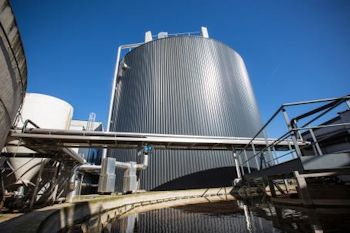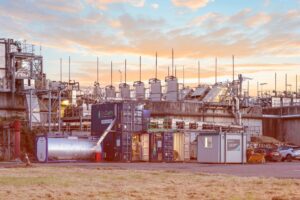Global Food Processor Remo-Frit Turns Wastewater and Solid Residues into Biogas and Green Electricity
A global exporter of processed potato products, Remo-Frit, has demonstrated the environmental and economic benefits of converting waste products into green energy, transforming a potential problem into a sustainable solution offering greater profitability.

Remo-Frit plant featuring Global Water Engineering technology (Image: Global Water Engineering)
Global Water Engineering Ltd (GWE) built a complete wastewater treatment plant and a RAPTOR plant for the solid residues of the Remo-Frit potato processing plant in Verrebroek, Belgium, where Flemish government Minister President Kris Peeters inaugurated the facility in the presence of GWE and Remo-Frit owners and top management. The Flemish Government invested 0.5 million Euro as a grant.
The Minister President congratulated all participants of the project and was very proud of the results obtained with the plant.
Europe’s food and beverage producers are highly focused on minimizing waste and making the most of by-products in re-use, recycling and recovery. Remo-Frit specializes in the production of fresh chilled potato products, manufacturing French fries and potato specialties and exporting a range of products to markets in Europe, America, Africa, the Asia-Pacific and elsewhere.
The Remo-Frit RAPTOR system inaugurated this year converts nearly all of the potentially environmentally harmful organic content of the solid wastes into green electricity and valuable fertilizer products. The RAPTOR process is complemented by and integrated with a high-efficiency GWE waste water treatment plant to achieve the very high waste water quality standards and the optimum biogas production efficiencies specified by Remo-Frit.
By harnessing both of its organic waste streams – contained in waste water and organic solids – the company is setting world green energy and water purity benchmarks for food processing, says Pascal Pipyn, Executive Vice President, Process and Research and Development for GWE, who represented GWE at the inauguration.
The RAPTOR process (or Rapid Transformation of Organic Residues) is a powerful anaerobic digestion process which in this application consists of a mechanical pretreatment of the organic residues (mainly the potato peels), thermophilic hydrolysis in a TAR (Thermophilic Acidogenic Reactor) followed by methane fermentation in a thermophilic digester of the ANAMIX-T type.
Out of a 3,300 m³ digester for the potato peels and primary sludge, GWE is able to produce up to 14,150 m³ of biogas per day from ± 230 Ton of organic residues per day (potato peels + primary sludge). On top of that, the anaerobic wastewater treatment plant produces another 3,350 m³ of biogas per day. Together, this amount of biogas is equivalent to 8,410 kg or 9,834 l of light fuel oil per day or 3,106 tons of fossil fuel a year, worth nearly Euro 3 million or nearly $US 4 million.
A biogas engine (CHP) of 1,200 kW was installed in a first stage of the project, a second one of about 500 kW is being ordered to be able to cope with increasing biogas production due to factory expansion.
Along with electricity production from biogas produced from wastewater and solid residue, steam is produced from the hot exhaust gases from the biogas engine. It is used for cooking higher grade organic residues intended for animal feed. The cooling water of the engine is used to maintain thermophilic conditions throughout the RAPTOR process and mesophilic conditions in the UASB (ANUBIX-B).
Waste Water Treatment Process
The ca. 3,500 m3 per week of waste water generated by the factory (5,000 m³ a week after expansion of the factory) is treated in a new primary clarifier, with the primary sludge sent to the RAPTOR plant, followed by an existing Upflow Anaerobic Sludge Blanket (UASB) type of anaerobic reactor of 2,045 m³, and further processed in a new nitrification/denitrification plant. Finally it passes to a new tertiary treatment with coagulation/flocculation and Dissolved Air Flotation (DAF) treatment.
This newly upgraded and expanded waste water treatment system is setting new benchmarks for waste water effluent quality. The system attains 99.5 per cent Chemical Oxygen Demand (COD) reduction, from 22,300 mg COD/l down to a very low 50/60 COD/l. Furthermore, nitrogen and phosphorous levels of less than 10 and 3 mg/l respectively are obtained.
Biogas produced from Remo-Frit’s waste streams undergoes sweetening (sulphur removal) for environmental and plant reliability purposes, using GWE’s BIO-SULFURIX process, followed by drying in GWE’s GASODRIX system. A set of blowers feeds the gas to the electric power generators. An environmentally friendly incineration type ground flare is installed for emergency purposes.
Energy savings produced by biogas production are achieved in perpetuity, with fossil fuel equivalent savings totaling $US40 million (nearly Euro 30 million) in the first decade at today’s prices.
Savings quickly repay the cost of the plant – typically inside two years – while achieving permanent environmental benefits by replacing fossil fuel, says the Chairman and CEO of GWE, Mr Jean Pierre Ombregt.
“Remo-Frit is setting world green energy and water purity benchmarks for food processing by harnessing both of its organic waste streams, in waste water and organic solids. This is a lead that can be followed by food and beverage processing companies globally, wherever they produce an organic waste stream,” says Mr Ombregt.
Food processors such as Remo-Frit – including breweries, fruit, food waste, agro industries, and energy crops including corn – can easily use this technology to generate energy for use in powering factory plant such as boilers or to feed electricity generation sets to produce electricity for the production plant or for feeding back to the local grid. The process can produce environmental and production efficiency gains globally.
The wastewater treatment plant sized for 1,000 m³/day is treating the factory wastewaters and the digestate of the RAPTOR™ process. It consists of a primary clarifier, a UASB type of anaerobic reactor (ANUBIX™-B), a pre- and post denitrification, a nitrification and post aeration, a clarifier and a final DAF for phosphorous removal with iron chloride. Finally the effluent is discharged in a river.
Source: GLOBAL WATER & ENERGY







